Develop and Implement
Details on completing an RCIS strategy document and best practices related to development process and CDFW review cycle

Developing an RCIS
Through feasibility and scoping, you know that an RCIS is the right approach for your goals, the benefits, and groups to engage. This section highlights key elements in developing the process that results in an RCIS document for CDFW to approve. The RCIS document provides a conservation vision and sets the stage for implementation pathways.
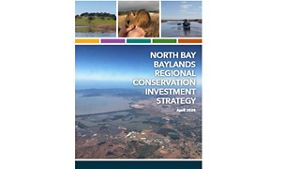
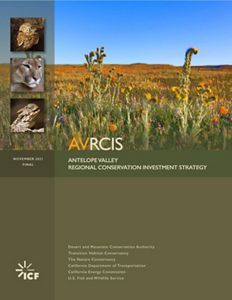
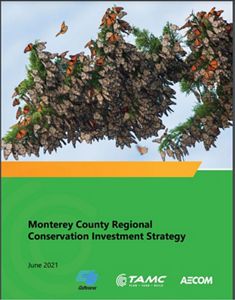
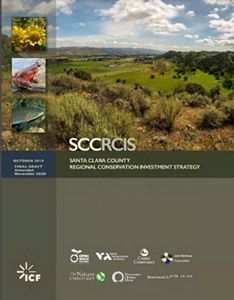

RCIS Cover page North Bay: Example of RCIS document cover page from North Bay Baylands RCIS 2024 © TNC

Antelope Valley RCIS cover: Cover for Antelope Valley RCIS strategy document November 2021 © TNC

Monterey County RCIS Strategy : Cover page of Monterey County RCIS Strategy document. June 2021 © TNC

Cover Santa Clara County RCIS: Cover of Santa Clara County RCIS strategy document. October 2019 © TNC
Launching the RCIS Process: Engaging Partners and Creating an RCIS Document for CDFW Approval
Understanding the guidelines, elements of an RCIS document, and outreach needs will inform the project scope. This outline includes details of key sections, including introductions, goals, environmental setting analysis, conservation opportunity areas, strategies, implementation plans, references, and appendices. The Guidelines and Program Fees are outlined in the CDFW RCIS Program Website. The Guidelines outline the required elements and processes, and recommendations to help guide development.
Additional information on RCIS Chapters, required and recommended, are also included: RCIS Common Elements, Value Added Elements, and RCIS Appendices.
RCIS Development Process
Preparation and Engagement
-
Read the CDFW RCIS guidelines.
The Guidelines provide essential information for developing and getting an RCIS approved by CDFW. Know what is required, and what is recommended.
Review other RCISs to consider typical RCIS outlines and organizational structures. Examples of other RCISs and elements common across all RCISs are listed below in the RCIS Common Elements link.
Important to consider elements that are not required but add value to an RCIS, depending on local interests and needs (see links below to Common and Value Added Elements).
This information will help spark ideas and approaches that would align with the goals and objectives of an RCIS in your region.
-
- Consider partners who would help guide the work to develop a group of invested organizations and people who can help manage and support the process.
- Consider partners who would find value in the RCIS to understand their goals and motivations to ensure their perspectives and needs are included throughout the process.
- Consider partners and organizations who would express support for funding requests.
-
- Develop a scope of work. (See an example of a scope of work here and high level project timeline.)
- Secure funding: Apply for funding from the Wildlife Conservation Board and assemble funding match.
- Issue an RFP and hire a consultant. A list of consultants used on approved RCISs to date is listed in the Resource tab under Reference documents.
-
Develop and begin to implement an Engagement Plan
RCIS Sponsors and consultants agree that the engagement process is one of the most critical, informative, resource intensive and rewarding elements of the RCIS development process.
The key pieces of an Engagement Plan for a RCIS include understanding why it’s important, designing the engagement plan and then implementing that plan. The attached presentation provides an excellent overview of how to go about designing and implementing an engagement plan for your RCIS. RCIS Engagement.
Outreach Communication: Informational Websites
Many RCIS proponents have created informational websites to inform, educate and engage partners and the public about the RCIS throughout the development process and facilitate its use and implementation.
Examples of two such RCIS project websites are the Kaweah RCIS and Monterey County RCIS
Remember to consult often with CDFW, other agencies and partners.
-
The total time for preparing an RCIS and the subsequent CDFW approval process is typically between two-three years. The CDFW approval process alone is approximately nine months.
Key tasks in developing the RCIS document includes:
- Project management
- Continuous outreach, communication and engagement
- Identify and describe existing regional conditions
- Identify focal species, non-focal species and other conservation elements
- Develop conservation strategy
- Describe implementation opportunities and adaptative management
- Consider and integrate feedback from the public and partners
- Incorporate existing reports and analysis in appendices
- Prepare RCIS document for submission to CDFW
-
CDFW will help you in planning your project and developing your strategy, so that it gives you a better chance for CDFW approval.
The total timeline includes:
- Proponent creating the RCIS strategy: The time for completion is heavily dependant on the urgency of the proponent to get the RCIS approved and the political will of the community to support the RCIS.
- CDFW Review and Approval Process: This process is publically available and is approximately 9 months.
Implement for value
-
Infrastructure agencies (such as transportation, water and energy) and developers of housing and commercial projects can use the RCIS to inform their plans and project designs to reduce risks to and build support for their projects.
Knowing the locations where there are sensitive species and habitats, and the areas of multi-benefit conservation value early, at the early planning stage can help guide plans and projects toward a more successful outcome. Infrastructure agencies and developers can invest in conservation and include nature in the design of their projects, guided by the information in the RCIS.
The information in the RCIS can help agencies and developers avoid and minimize environmental risks, and if necessary, align compensatory mitigation with conservation priorities.
Infrastructure agencies and developers can develop Mitigation Credit Agreements and generate advance mitigation credits that they can use for their projects, sell or transfer to others. See the MCA section for details.
-
Once an RCIS is approved, any entity — public or private — can develop Mitigation Credit Agreements, which outline conservation actions that are consistent with the RCIS, that can generate advance mitigation credits. MCAs can be developed for a range of reasons:
An infrastructure agency that has a pipeline of projects in the planning stage can develop an MCA to address anticipated mitigation needs for specific species and habitats, allowing the agency to align mitigation investments with approved conservation priorities, reduce their mitigation obligations and costs, and streamline projects’ permitting. Agencies can get ahead and stay ahead of future mitigation needs, and develop stronger partnerships with resource agencies.
A conservation organization can develop an MCA to secure mitigation funding for planned conservation priority actions that need funding from multiple sources.
A special district (open space or resource conservation district) can develop an MCA to help mitigate for conservation projects that may need mitigation (such as wildlife connectivity projects), and can sell excess mitigation to help pay for their projects.
A mitigation or conservation banker can use the RCIS to identify locations for MCAs and create MCAs as another product in their offerings. Moreover, a banker can develop an MCA for non-permanent credits.
-
Conservation organizations that are seeking public and private funding for conservation actions can reference that the actions are included in an approved RCIS as a demonstration of public and agency support to boost support for your application.
Conservation and other entities can use the RCIS to guide conservation investments, leveraging the science-based information that identifies conservation priorities, actions that benefit species and habitats, habitat connectivity and climate adaptation and resilience.
-
The outreach and engagement that was central to the development of the RCIS can broaden and deepen understanding of conservation needs and the value of conservation in a region, build allegiances and relationships with new partners, and generate support for conservation.
Similarly, new partnerships can help advance infrastructure projects that incorporate nature-based solutions and design functions, integrating nature into the built environment.
The communications tools that are developed, including websites, scientific analyses, blogs, presentations and the RCIS itself can be used to develop and build support for a conservation vision in a region, expanding the web of conservation partners in the region and building support for implementing the conservation vision.
-
Create a team to help manage the Engagement work that will provide a broad base perspective into the RCIS design. The key groups to advise on decisions, inform interested organizations and engage partners, agencies, users and other stakeholders consist of RCIS proponents, infrastructure agencies, regulatory agencies, scientists, local and regional planners, as well as community based organizations. An outline of these groups and their roles in RCIS Engagement is outlined here.
-
If there may be plans in the future for an MCA, the RCIS is required to have an outline for monitoring and adaptively managing the conserved habitats and other natural resources to be eligible for mitigation credits.
All RCISs to date include these outines and an example of this outline can be found in North Bay Baylands RCIS Chapter 5.3.

How to use the RCIS: Guidance from two different RCIS proponents
The RCIS can be used by a range of entities and for a variety of purposes such as conservation organizations. land managers, infrastructure agencies, project proponents and regulatory agencies. Two RCIS “How to Use” guides are in the tabs below.
Project management and CDFW approval timeline
The RCIS Development Process is time and resource-intensive. RCIS Sponsors should expect the RCIS process to take two-three years from start to CDFW approval, factoring in the almost nine-month public review, CDFW review and approval process.
Below are two examples of project management timelines — one for the overall project timeline, highlighting the key milestones and the CDFW approval timeline. The CDFW Development, Review and Approval Flowchart can be found here.
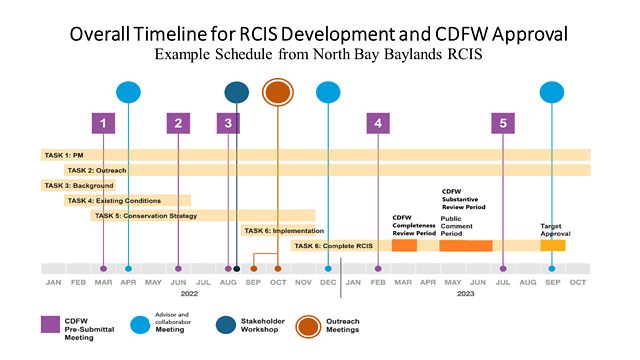
This graphic depicts an example schedule from North Bay Baylands RCIS for RCIS development and CDFW approval. It shows a variety of tasks that take place between January 2022 and October 2023, along with a variety of milestones, including CDFW pre-submittal meetings, advisor and collaborator meetings, stakeholder workshops, and outreach meetings.
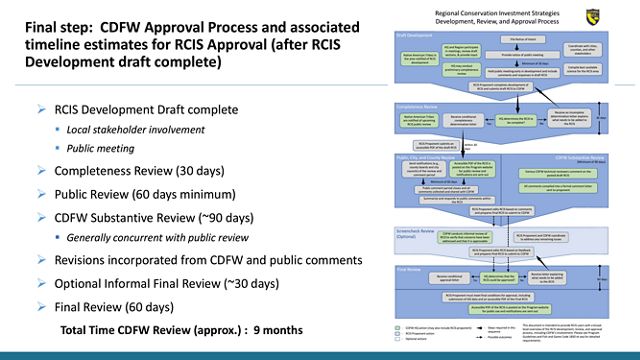
This graphic details the final step of RCIS development, the CDFW approval process. Specifically, it mentions the completion of the RCIS development draft, the completeness review, the public review, the CDFW substantive review, the incorporation of revisions from CDFW and public comments, the optional informal final review, and the final review. All of these components of the CDFW review are expected to take approximately nine months.